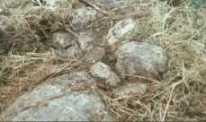S t o n e R o w s W h i t i n K o u n o v P l a i n
.. 13°41´43´´v.d.; 50°13´32,2´´s.š. ; 525m ..
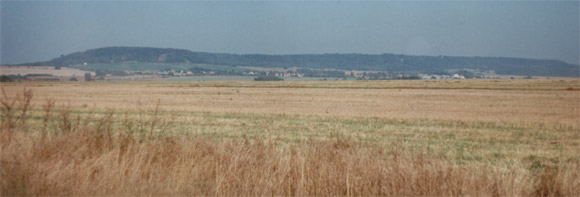
Since year 1995 our team has been systematically engaged in a research of always mysterious stone formations. The main aim of our work is to search for mutual links between these an-made creations and astronomy. In particular we look for their relationship towards Sun and Moon positions during equinox, solstices, as well as the positions of bright stars-Sirius (the brightest star of northern sky within Big Dog constellation), Capell or Arctoor, or in relation to bright planets like Venece and Jupiter are.
 ... map lokalitis Kounov ...
... map lokalitis Kounov ...

At the same time we assume the architects could had been those inhabitants living within our territory during the last half a century B.C.; we look for possible links within their major feasts, e.g.
Celtic Samain (November 1), Imbolc (February 1), Beltine (May 1) and Lugnasad (August 1).
The figures in parentheses show their approximate dates compliant to our current calendar.
So far stone lines have been found within the following localities:
Kounov (Rakovník)...14-16; Nečemice...4,1; Kluček (Louny)...2; Rokle (Chomutov)...1; Bylany (Kutná Hora)...4-6; Zvotoky-Skalice (Strakonice)...3;
Bezdědovice...4-5; Sedlice (Strakonice)...10; Žihle (Plzeň)...?
Very typical are those well-known Kounov lines, localities within Špičák, Nečemice, and others lying in the direction of sunset on summer solstice. We suppose these are not-despite close to each other and independent localities-but one single megastructure discontinued at several points further on by nature or human being activities. In the past it could had been a locality eight kilometer long, thus daringly competing with similar structures in France. Finding of individual stones along with larger formations as well outside already known localities could serve as a proof to this theory.
At a distance of 980 km from a crossroad between a tourist path marked yellow and road Kounov - Domoušice in direction to Domoušice the road is crossing a row that most likely led beneath Rovina (plain) slope, in direction towards 512,7 elevation. A well-known stone called Paegas belonging to Kounov formation rests on the abovementioned solstice line 1 km away from here.

An independent row 15 km long within line 280° lying 250 m from Nečemice rows is in south direction. In addition there is a stone row crossed by a wood path 300 m above gamekeeper´s lodge called Nový svět pointing towards a road leading to Třeskonice.
The stones are of the same structure like the main Necemice section. Then there is a stone resting on a hill 450 m southward from elevation 418 m called Vlčí důl (Wolf Pit). It is an ideal spot for a "wiseer" with a nice view to Výrov, a forest containing Nečemice rows, Špičák and part of Rovina area. Still another stone line oriented East-West can be found 200 m away from here in north-west direction on the slope of broadleaf and mixed woods. The rows east edge then continues with another row in north-south direction ended by several large stones near the end of the wood. Most likely these are the stones removed from the field originally positioned within solstice line up to the Kluček. For sure it is not a randomly formed group of stones. Some of them show certain signs of workmanship. Looking briefly in a geological map it becomes obvious that some of these formations as well as individual Menheers lie just at the spot of geological faults (taking into account our vicinity alone we get the Virgin near Rakovník, Klobucký pastýř, Hředle, Drahomyšl, Slavětín, etc.)
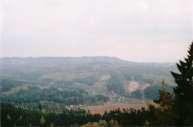

Mr. B. Krčmář is the person engaged in finding faults using the method of element´s molecular form. (archeological views 99)
The aforementioned implies that Paegas stone lies exactly on the spot where at least three fault structures cross each other, and this in the N-S, E-W, NE-SW directions. This is most likely what causes energetic perceptions of dowsers and sensible people.
Much to our regret we have found that devastation of this unique formation continues due to timber exploitation. This has not ceased even after education path was established commencing from nearby Mutějovice railstation.
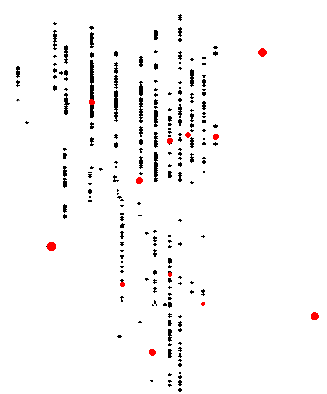
Since already Mr. Helšus in his book Stone Queries or else Megalites in Bohemia has described this locality in detail, we have therefore aimed our attention to something little bit different. We split the rows into northern and southern parts, depending on which side of the path it lies.

We were motivated by an effort to catch the appearance of the rows in as much detail as possible before it actually disappears completely.
On the southern side with Paegas three rows in direction from the field had already disappeared with only the eradication and stubs left. The northern section is much more well-preserved, stones of some of the lines are hidden within dense growth or stay or remain behind fencing of little trees.
We have mapped the lines one by one along with distances and sizes of the stones. Those stones larger than 1,5 m are marked red.
The map containing marked stones exceeding 1 m.
We only mention dimensions of those visible stone parts since quite comprehensibly we did not unearth the stones - what we did at the maximum was removing needles and leaves.
Just a couple of years ago you were able to count even as much as 2000 stones, whereas nowadays their amount would hardly swing over nine hundred.
It is clear that some of the stones had been worked. By this we do not mean any cracks (fissures) or fractures caused most likely by heating up followed by fierce cooling down. The stones like that contain holes always 2-3 cm in diameter and 10-15 cm deep. The hole in one of the stones found is even passing through.



We should exclude any water affects. The holes seem to be made by a human creature. They were not supposed to help break a stone since not so massive pieces are involved thus able to be transported as one entire piece.

One exception is a stone within Špičák (Peak) locality. The sandstone 240 x 110 x 40 cm had been drilled on with three aligned holes in its middle part at a distance of 20 cm between each of the holes that were likely supposed to help break the stone in pieces more easily. The work had been never finished. In case these holes were made using metal tools, then there should be some traces of analytically recognizable amount of metal, either copper or iron, left inside the holes. It would be therefore rather appropriate to make comparison measurements of the samples. It might prove to be quite helpful when trying to provide the rows with dates compliant to type of metal applied. Surely, a later workmanship using different methods cannot be excluded.

There is an interesting fact that length-to-width ratio of the stones equals to about 2 : 1. Quite frequently the upper edge of the stones is pointing to N-S; or stones with their western side beveled: stones very similar to each other in their shape.
Most stones (1 m) are accompanied by smaller ones (20 cm) colored red-brown. Originally the stones had been seated in a bed formed by tiny stones that have a kind of a horseshoe on their bottom side making them better anchored in the ground.


One of the most peculiar stones can be found in row 5. southward, about 122 m away from the path. It is a greenish quartzite containing white streaks not able to be found anywhere else. Genuinely this stone was about 2 m high, and now split into three parts.


We have devoted our attention to Paegas Stone during equinox 1998.
We managed to place a bearing stick 1 m long into the slot (cut-out) on the stone, and we watched a shadow being projected on the stone a time round noon when it ran parallel with the longest groove.

The quartzite must had been carried over up to these mountains (we mean Vinařická Hill and Slánská Hill) contrary to quartzite stones aligned in a row above Kounov. According to geological research of Mr. Žebera (1981) that quartzite and conglomerates had managed to survive disturbing period of Tertiary Era and remained on Rovina (Plains) until they became a lying obstruction on a field.
Zd. Ministr, Slánský obzor č.5/98
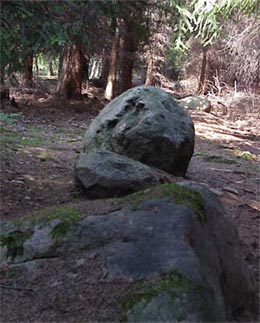
So called Czech Stonehenge is a title of actually no sense in cases a name Czech Carnac could be applied at most, but nevertheless it shows rather persistently within newspaper´s articles despite its best years have already past over, hopefully. The upper plain near KOUNOV between Rakovnik and Louny has been known ever since 1934 of its 14 (16) rows stretching over in cross direction 200 to 300 m long. Right back during the year 1934 a hypothesis had arisen concerning its megalitic nature and high age. Various assumptions were stated in hundreds of predominantly newspaper articles, friends of archeoastronomy did measure them, and these guys brought some professional archeologists over here back in seventies, along with geologists searching over this area. An what the results are like? The rows are formed by numerous stones of smaller to tiny size, nothing similar to that of Breton lines. No astronomic orientation has been proved, no evidence of their prehistoric age found-however traces of ploughing (tilling) were observed, which is in conformity with the old maps´ suggestions and statements pronounced by witnesses that the origin of the lines is of modern times: most likely they were formed during 19th century upon parceling (ground plotting) the noble woods into narrow long fields in such a way that the bigger stones were brought down to the land boundaries. Similar false row localities were found during the glory times of Kounov within surrounding area, and we know them even from other places like for instance in France, as well. Certainly there are rows that differ in character from those of Western Europe: In Corsica for example we can find lines forming menheer statues worth to be mentioned due to their potential significance to clarify their meaning. Mr. K. Sklenář; Tanec obrů (Dance of the Giants), Není jen Stonehenge,(Stonehenge is not the only) on year 96)
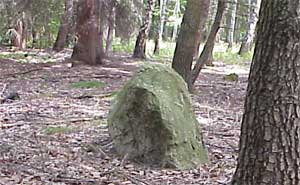
Maybe it is just a sort of Czech syndrome to look with envy towards the world wondering what everything other countries possess to show to others and able to be researched, but it might be that if let us say in USA they had so many thousand-year old villages full of belfries, little chapels, sculptures, churches along with such a rich history like here in Bohemia, certainly they should not feel shameful that somewhere in Egypt they own pyramids. On contrary, they would surely declare America a continental reservation and their pride for their origin would then finally gain a meaning. But here we take just the opposite approach-being a tiny spot on the map of Europe we do not esteem our history any more and "cheerfully" try to gain as much as possible out of everything that money cannot be milked therefrom. Why not to enlighten the sense of anything we have at our homeland whatever that sense might be! The statuette of "Věstonická Venuše" (Venus) has nei ther been two meter high and for sure we do not concede it as an item of no significance. It serves as evidence of something valuable. What the aligned stones are an evidence of? Why answers to these questions are always missing?
Already back in 1936 Messrs. J. Šmíd and J. Korelus had brought the stone rows discovered by Mr. Patejdl, a teacher, from Kounov out to people´s attention.
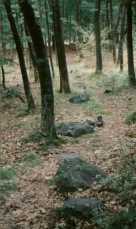
Despite all the endeavor to unveil the mystery of rows only guesses and conjectures remain. It by far is not a shame on behalf of newspaper reporters that they first started reporting about stone lines whereas professionals just overlooked them. Now it would be only useless to moan that no thorough and systematic research had not been carried out already before, and that competent people made no effort what so ever, let alone a deeper interest shown to explain their existence within Bohemian territory. The rows, likely for somebody, unluckily for all, disappear while not having been understood and never to reoccur again. The fact that tilling might had been carried out on these plains sometime during 19th century should not be taken into account to clarify existence of the rows. Even today we live on the places of former fortified settlements and other historical settlements, we plough apart old Celtic routes and ruins of their settlements without being able to affirm that by doing these automatically become modern structures.








